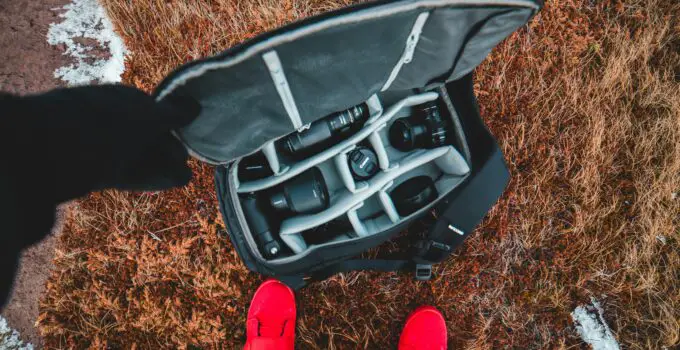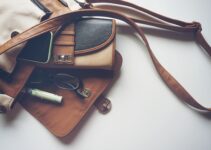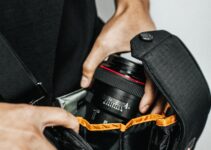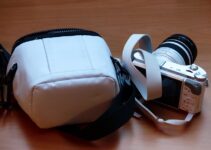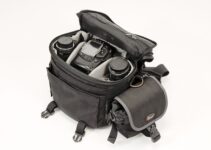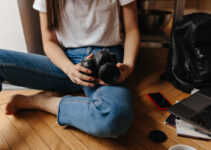Wondering how to expertly store your precious Nikon camera in a bag without risking damage?
Whether you’re a photography enthusiast or a professional, ensuring your camera’s safety on the go is paramount.
In a nutshell, securely store your Nikon camera in a padded compartment, wrap delicate accessories like lenses in soft cloth, and use dividers to organize and protect equipment from scratches or impacts.
But what about those small yet essential details that make a big difference?
Discover pro tips from renowned photographers like Annie Leibovitz to maximize your camera bag’s efficiency and safeguard your photography gear on every adventure.
How to store Nikon camera in bag?
Storing a Nikon camera in a bag requires careful handling to ensure its safety and longevity. Here are step-by-step instructions on how to do it:

- Turn Off the Camera: Before storing your Nikon camera in a bag, ensure that it is turned off. This helps prevent accidental power drain and damage.
- Remove the Lens (if applicable): If your camera has an interchangeable lens, it’s often a good practice to remove it before storing. This prevents any strain on the lens mount and reduces the risk of damage.
- Secure Accessories: If you have any accessories such as extra lenses, filters, or flash units, make sure they are securely placed in the bag’s compartments or pouches designed for them. Avoid loose items that could potentially scratch or damage the camera.
- Use a Padded Bag or Insert: Choose a camera bag that offers adequate padding and protection. If your bag doesn’t have built-in padding, consider using padded inserts to cushion the camera and its accessories.
- Position the Camera Carefully: Place the camera in the bag in a way that minimizes movement. If there are adjustable compartments in the bag, customize them to fit the camera snugly without being too tight.
- Protect the LCD Screen and Viewfinder: If your camera has an LCD screen or a viewfinder, consider using a screen protector or a protective cover to prevent scratches or smudges.
- Secure Zippers and Closures: Close all zippers and fasten any closures on the bag to ensure that the camera and accessories stay securely inside during transportation.
- Avoid Extreme Temperatures and Humidity: Store your camera bag in a cool, dry place to protect it from extreme temperatures and humidity, which can damage electronic components and lenses.
- Regularly Check and Clean: Periodically check your camera bag for any signs of wear or damage. Clean the bag as needed to remove dust, dirt, or debris that could harm your equipment.
By following these steps, you can store your Nikon camera safely in a bag, ensuring its protection and longevity for future use.
Is it difficult to store a Nikon camera in bag?
Storing a Nikon camera in a bag is not inherently difficult, but it does require attention to detail to ensure the camera’s safety and functionality.
The process involves several steps such as turning off the camera, removing interchangeable lenses (if applicable), securing accessories, using a padded bag or insert, positioning the camera carefully to minimize movement.
Thus, protecting the LCD screen and viewfinder, securing zippers and closures, and storing the bag in a suitable environment.
While these steps may seem straightforward, they are important for preventing damage to the camera and its components.
Here, what’s your favorite camera bag for accessories?
With a bit of care and organization, storing a Nikon camera in a bag can be done effectively without much difficulty.
Regular maintenance and cleaning of the bag also contribute to keeping the camera safe and ready for use.
What steps do I need to remember before storing Nikon camera in bag?
Storing your Nikon camera in a bag is a crucial aspect of maintaining its functionality and longevity.
Proper storage helps protect the camera from physical damage, dust, moisture, and other environmental factors that could affect its performance.
Here are the essential steps to remember before storing your Nikon camera in a bag:
- Turn Off the Camera:
- Always ensure that your Nikon camera is turned off before storing it in a bag. This not only conserves battery life but also prevents any accidental button presses or changes to settings.
- Check for Accessories:
- Remove any accessories attached to the camera, such as lenses, filters, memory cards, or external flash units. These accessories should be stored separately or in designated compartments within the camera bag.
- Clean the Camera:
- Before storing your camera, it’s a good practice to clean the exterior to remove any dust, fingerprints, or debris. Use a soft, lint-free cloth to gently wipe the camera body, lens mount, and LCD screen.
- Protect the Lens:
- If your camera has an interchangeable lens, consider using a lens cap or rear lens cap to protect both the front and rear elements of the lens. This prevents scratches, dust, and moisture from accumulating on the lens surfaces.
- Use a Padded Bag or Insert:
- Choose a camera bag that provides adequate padding and protection for your Nikon camera. Padded bags or inserts help cushion the camera and absorb shocks during transportation.
- Position the Camera Carefully:
- When placing the camera in the bag, ensure that it is positioned securely and does not move around excessively. Use adjustable compartments or dividers within the bag to customize the fit for your camera and accessories.
- Secure Small Items:
- Small accessories such as lens caps, memory cards, batteries, and cables should be stored in separate compartments or pouches within the camera bag. This prevents them from getting lost or causing damage to the camera.
- Protect the LCD Screen and Viewfinder:
- If your Nikon camera has an LCD screen or an optical viewfinder, consider using a protective film or cover to prevent scratches, smudges, or dust buildup. This helps maintain clear visibility and functionality.
- Close Zippers and Fastenings:
- Ensure that all zippers, buckles, straps, and closures on the camera bag are securely fastened. This prevents the camera and accessories from accidentally falling out or getting damaged during transport.
- Store in a Suitable Environment:
- Choose a cool, dry, and well-ventilated storage location for your camera bag. Avoid storing it in extreme temperatures, direct sunlight, or high humidity, as these conditions can damage electronic components and lenses.
- Regularly Inspect and Maintain:
- Periodically check your camera bag for any signs of wear, damage, or malfunctions. Clean the bag as needed to remove dust, dirt, or stains that could potentially harm your equipment.
By following these steps, you can ensure that your Nikon camera is stored safely and securely in a bag, ready for use whenever you need it.
Proper storage practices not only protect your investment but also contribute to the optimal performance and longevity of your camera equipment.
9 steps to store Nikon camera in bag
Step 1: Turn Off the Camera
Before storing your Nikon camera in a bag, it’s crucial to turn off the device.
Here, top 10 small DSLR camera bag.
This simple step helps conserve battery life and prevents any accidental button presses or changes to settings while the camera is in storage.

Modern digital cameras like Nikon models often have various power-saving features, but turning off the camera completely adds an extra layer of protection and ensures that no unnecessary drain occurs.
Turning off the camera is typically done by pressing the power button until the display or indicator lights turn off.
Some cameras may also have an automatic power-off feature after a certain period of inactivity, but it’s still advisable to manually turn off the camera before storing it in a bag.
By doing so, you minimize the risk of battery depletion during storage, especially if you won’t be using the camera for an extended period.
Step 2: Remove Any Attached Accessories
If your Nikon camera has any accessories attached, such as lenses, filters, external flash units, or grips, it’s essential to remove them before storing the camera in a bag.
This step helps prevent strain on the camera’s mount and ensures that the accessories are stored safely and separately.
When removing accessories, handle them with care to avoid damaging delicate components like lens elements or electrical contacts.
For lenses, always replace the front and rear lens caps to protect the glass surfaces from dust, scratches, or accidental impacts.
Similarly, detach any external flash units or grips and store them in designated compartments or pouches within the camera bag.
Removing accessories not only protects the camera and its components but also allows for better organization within the bag, making it easier to access specific items when needed.
It’s a good practice to keep accessories organized and secure to avoid misplacement or damage during transportation.
Step 3: Clean the Camera and Accessories
Before placing your Nikon camera and accessories in a bag, take a moment to clean them to remove any dust, fingerprints, or smudges.
Use a soft, lint-free cloth designed for cleaning camera equipment to gently wipe the camera body, lens surfaces, and LCD screen.
Cleaning the camera and accessories not only keeps them looking good but also helps maintain their performance and functionality.
Dust and debris can accumulate over time, leading to potential issues such as sensor spots, lens flare, or degraded image quality.
By regularly cleaning your camera gear before storage, you reduce the risk of these problems occurring.
When cleaning lenses, be cautious not to apply excessive pressure or use abrasive materials that could scratch the lens coatings or glass elements.
For the camera body and LCD screen, use gentle, circular motions to remove dirt and smudges without leaving streaks or scratches.
If necessary, you can also use specialized lens cleaning solutions or wipes for stubborn stains or marks.
Step 4: Protect the Lens with Caps
If your Nikon camera has an interchangeable lens, it’s essential to protect both the front and rear elements of the lens before storing it in a bag.
Use lens caps or covers to shield the lens surfaces from dust, scratches, and moisture.
The front lens cap is designed to cover the outermost element of the lens, which is susceptible to damage from environmental factors and accidental contact.
By keeping the front lens cap on when the lens is not in use, you safeguard the delicate glass surface from scratches and dust particles that could affect image quality.
Similarly, use a rear lens cap to protect the rear element and lens mount of the interchangeable lens.
This prevents dust, moisture, or debris from entering the lens cavity and affecting the lens’s performance or causing damage to the camera’s mount.
When attaching lens caps, make sure they fit securely and are not loose, as loose caps can easily fall off during transportation.
Properly protecting your lenses with caps ensures that they remain in optimal condition and ready for use when you need them.
Step 5: Choose a Padded Bag or Insert
Selecting the right camera bag is crucial for storing your Nikon camera safely and securely.
Look for a bag that offers adequate padding and protection to cushion the camera and its accessories during transportation and storage.
Padded camera bags or inserts are designed with soft, shock-absorbing materials that help minimize impact damage if the bag is bumped or jostled.
The padding also provides insulation against temperature changes and adds an extra layer of protection against moisture and dust.
When choosing a camera bag, consider the size and configuration that best fits your Nikon camera and accessories.
Look for compartments, dividers, and pockets that allow you to organize and secure items efficiently.
Adjustable dividers are particularly useful for customizing the interior layout of the bag to accommodate different gear configurations.
Step 6: Position the Camera Carefully in the Bag
Once you have selected a padded camera bag or insert, it’s time to carefully position your Nikon camera inside.
Place the camera in a way that minimizes movement and prevents it from shifting or sliding around during transportation.
If the bag has adjustable compartments or dividers, customize them to fit the camera snugly without applying excessive pressure.
Avoid overcrowding the bag or forcing the camera into a space that is too small, as this could potentially damage the camera or accessories.
Positioning the camera carefully not only ensures its physical protection but also makes it easier to access and retrieve when needed.
Organize other accessories such as lenses, batteries, memory cards, and cables in designated compartments within the bag to keep them secure and prevent them from getting tangled or damaged.
Step 7: Secure Small Items in Separate Compartments
In addition to the camera body and lenses, you may have other small items such as lens caps, memory cards, batteries, chargers, or cables that need to be stored in the camera bag.
It’s essential to keep these items organized and secure in separate compartments or pouches within the bag.
Small accessories like lens caps can easily get lost if not properly stored.
Use designated pockets or pouches within the camera bag to keep them safe and easily accessible when needed.
Similarly, store memory cards, batteries, and chargers in their respective compartments to avoid confusion and ensure they are ready for use.
Securing small items separately not only prevents them from getting misplaced but also minimizes the risk of damage or accidental contact with the camera or lenses.
A well-organized camera bag with designated compartments for each item makes it easier to find what you need quickly without rummaging through clutter.
Step 8: Close Zippers, Buckles, and Fastenings
Before transporting or storing your Nikon camera bag, ensure that all zippers, buckles, straps, and other fastenings are securely closed and fastened.
Properly closing the bag prevents the camera and accessories from accidentally falling out or getting damaged during movement.
Check each zipper to make sure it is fully closed and engaged, especially if the bag has multiple compartments or openings.
Fasten any buckles or straps to secure the bag’s contents and distribute weight evenly for comfortable carrying.
If your camera bag has additional security features such as lockable zippers or TSA-approved locks, consider using them to add an extra layer of protection against theft or unauthorized access.
Always double-check that the bag is fully closed and secure before lifting or carrying it to avoid any mishaps.
Step 9: Store in a Suitable Environment
Once your Nikon camera is safely stored in a padded bag with all accessories secured, choose a suitable environment for storage.
Ideally, store the camera bag in a cool, dry, and well-ventilated area away from direct sunlight, extreme temperatures, or high humidity.
Exposure to extreme heat, cold, or moisture can damage electronic
7 tips to pack a Nikon camera bag
Tip 1: Organize Your Gear Before Packing
Before packing your Nikon camera bag, take some time to organize your gear.
Make a checklist of all the items you’ll need for your photography session, including the camera body, lenses, filters, memory cards, batteries, chargers, and any other accessories.
Lay out all the items and prioritize them based on their importance and frequency of use during your shoot.
Divide your gear into categories such as camera body and primary lens, secondary lenses, accessories, and personal items.
This helps you visualize how everything will fit in the bag and ensures that you don’t forget any essential equipment.
Tip 2: Use Protective Cases or Pouches for Small Items
Small accessories like lens caps, memory cards, batteries, and cables can easily get lost or damaged if not properly stored.
Use protective cases or pouches to keep these items organized and secure within your Nikon camera bag.

Invest in padded pouches or cases designed specifically for camera accessories. Label each case or pouch accordingly to quickly identify its contents.
This not only protects your gear from scratches and impacts but also makes it easier to find what you need without rummaging through the bag.
Tip 3: Utilize Adjustable Compartments and Dividers
Most camera bags come with adjustable compartments and dividers that allow you to customize the interior layout according to your gear.
Take advantage of these features to create dedicated spaces for your camera body, lenses, flashes, and other accessories.
Arrange the compartments and dividers to fit your gear snugly without overcrowding or applying excessive pressure.
This helps prevent items from shifting or bumping into each other during transport, reducing the risk of damage.
Tip 4: Distribute Weight Evenly
When packing your Nikon camera bag, distribute the weight evenly to ensure comfortable carrying and balanced weight distribution.
Place heavier items such as camera bodies or large lenses at the bottom of the bag to create a stable foundation.
Avoid stacking too many heavy items on top of each other, as this can strain the bag’s straps and cause discomfort when carrying.
Place lighter accessories or personal items on top or in side pockets to balance the weight and maintain a manageable load.
Tip 5: Secure Fragile Items with Padding
Fragile items such as lenses, filters, or delicate accessories require extra protection during transport.
Use padded inserts, lens wraps, or protective cases to cushion and secure these items within your Nikon camera bag.
Wrap lenses in soft microfiber cloths or padded lens wraps to prevent scratches and impacts.
Place them in designated compartments with sufficient padding to absorb shocks and vibrations.
Similarly, use padded cases or wraps for filters, flashes, and other fragile accessories to keep them safe during travel.
Tip 6: Consider Weatherproofing Options
If you anticipate shooting in challenging weather conditions or outdoor environments, consider weatherproofing options for your Nikon camera bag.
Look for bags made from durable, water-resistant materials with sealed seams and waterproof zippers.
Invest in rain covers or waterproof sleeves designed specifically for camera bags to protect your gear from rain, snow, dust, and moisture.
Keep these covers easily accessible in a dedicated pocket or compartment so you can quickly deploy them when needed.
Tip 7: Maintain Accessibility and Quick Access
While organizing your Nikon camera bag, prioritize accessibility and quick access to frequently used items.
Place essential gear such as your camera body with a primary lens in easily reachable compartments or pockets.
Designate specific pockets or pouches for items like spare batteries, memory cards, lens cleaning kits, and personal belongings such as keys or a smartphone.
Keep these items organized and separate from your camera gear to avoid confusion and ensure quick retrieval when shooting on the go.
Additional Tips:
- Label Your Bag: Use luggage tags or labels to identify your camera bag easily, especially when traveling or in crowded settings.
- Regularly Clean Your Bag: Periodically clean your camera bag to remove dust, dirt, and debris that could potentially damage your gear.
- Use Locks or Security Features: Consider using locks or security features on your camera bag to prevent unauthorized access and theft.
- Optimize Space: Maximize space in your camera bag by packing efficiently and using collapsible or foldable gear when possible.
- Check Weight Limits: Be mindful of weight limits for airline travel if you plan to carry your camera bag as carry-on luggage.
By following these tips, you can pack your Nikon camera bag effectively, ensuring that your gear is organized, protected, and readily accessible for your photography adventures.
Related faq’s
How do you put a Nikon camera in a bag?
To put a Nikon camera in a bag, follow these steps:
- Turn off the camera.
- Remove any attached accessories.
- Clean the camera and accessories.
- Protect the lens with caps.
- Choose a padded bag or insert.
- Position the camera carefully in the bag.
- Secure small items in separate compartments.
- Close zippers, buckles, and fastenings.
- Store the bag in a suitable environment.
How do you store a camera in a camera bag?
To store a camera in a camera bag:
- Turn off the camera.
- Remove accessories like lenses.
- Clean the camera and accessories.
- Protect the lens with caps.
- Choose a padded camera bag.
- Position the camera securely in the bag.
- Secure small items in separate compartments.
- Close zippers and fastenings.
- Store the bag in a cool, dry place.
How do I store my Nikon camera?
To store your Nikon camera:
- Turn off the camera.
- Remove any attached accessories.
- Clean the camera and accessories.
- Protect the lens with a cap.
- Place the camera in a padded bag.
- Position it securely in the bag to prevent movement.
- Store small items in separate compartments.
- Close zippers and fastenings.
- Choose a cool, dry location for storage.
Can I put my camera in my bag?
Yes, you can put your camera in a bag, preferably a camera bag designed specifically for storing and transporting camera equipment.
A camera bag provides padding, compartments, and protection tailored to the needs of cameras and accessories.
It helps safeguard your camera from damage due to bumps, knocks, moisture, and dust during transportation.
Using a camera bag also allows for organized storage, ensuring that your camera and accessories are securely held in place and easily accessible when needed.

